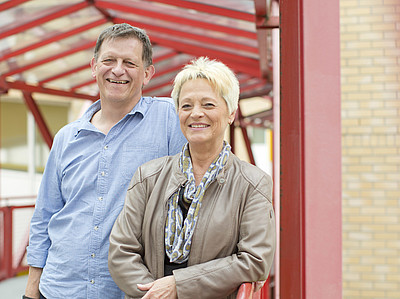You are here
Content
Centres of excellence
- Kidney diseases (nephrology)
- High blood pressure (hypertensiology)
- Hormonal disorders (endocrinology)
- Diabetes (diabetology)
- Pneumology (lung diseases)
- Metabolic disorders
- Chronic inflammatory joint diseases (rheumatology)
- Kidney transplants
Kidney transplant
Hope for a new life through kidney transplant
The waiting list for a donor kidney for a kidney transplant is long: potential recipients have to wait for a new organ for an average of eight to ten years. Living kidney donations – the alternative to a donation post mortem – result in this waiting time being reduced or avoided entirely.
Kidney Transplant: Long waiting time
A kidney transplant is always up for debate when a patient suffers from chronic kidney failure and relies on renal replacement therapy, in which toxins are removed from the blood by means of dialysis. In order to undergo this treatment the patients have to go to hospital as a rule three times a week for four to five hours. “The normal course of the patients’ lives is determined and significantly restricted by this strenuous haemodialysis,” explains Professor Bernd Krüger, spokesman and director of nephrology at the transplantation centre of the Mannheim University Teaching Hospital. “For this reason, a transplant is always the therapy of choice with regard to the gain in independence and quality of life.” With their first dialysis, patients can be allocated a place on the waiting list for an organ donation from a deceased person – and then the long waiting starts.
A donation of happiness - Kidney Transplant
This waiting time can be avoided by making use of a living kidney donation. For this purpose, a healthy person donates one of his or her two kidneys to a person with whom an emotional attachment exists. A living kidney donation for a kidney transplant is possible between married couples and life partners, parents and children as well as siblings and friends of long duration. The potential donor undergoes a careful examination and is informed of the potential risks of the operation. As a rule, the donor’s health will not be impaired by the procedure. At the Mannheim University Teaching Hospital the removal of the organ is carried out by means of an especially gentle and minimally invasive procedure leaving only minimal scars so that the donor can usually be discharged from hospital after approximately one week. For his or her part, the recipient is given a new life: “A living kidney donation can be planned more efficiently than a transplantation post mortem, meaning that the recipient can undergo surgery in a better state of general health,” says Professor Krüger. “In our experience, organs transplanted from living donors work more effectively and for a longer time.”
Years of expertise
With the use of living kidney donations the world of medicine has overcome the limits of the donation post mortem: transplantation is possible without any loss of function even in the case of a blood-group incompatibility between donor and recipient or in the event of specific antibodies existing. “We can prescribe medication to prepare the patient for a different blood group. Many years ago, we were the second medical centre in Germany to carry out such a kidney transplantation and since then we have gathered a wealth of experience.”
Context Column
About the International Patient Office
The International Patient Office (IPO) welcomes patients from all over the world and assists with requests for medical treatment. Click here to read more about the IPO.

